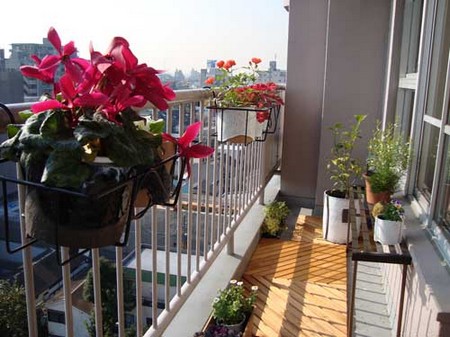There is such a wonderful variety of climbing and trailing plants that have decorative foliage, wonderful flowers and sometimes bright fruits too, that choosing just two or three for a balcony can be very difficult. Unless the area is a large one, you are unlikely to be able to choose more than a couple of plants. Your wall or screening will offer the protection and support they need to flourish and your final selection will be influenced not just by the prevailing climate in your area, but also by whether they will be in a protected sunny position or a colder, windy one. For example, save your camellia, honeysuckle and jasmine for decorating north- and east-facing trellises, because a sunny aspect will better suit the lovely lilac-flowered wisteria or one of the vigorously flowering Solarium family.

Plants for quick cover
The majority of climbing plants shoot up so quickly they are a pleasure to grow — they will partly smother and soften a trellis or overhead structure within a single season. Many are also sweetly scented, so add another dimension to your balcony scheme. Luckily most will be happy if planted in a large pot, tub or container, provided they are given the right type of soil (some will not tolerate an alkaline compost) and are fed regularly to keep pace with their rapid growth. Some may need pruning or training into position, particularly if they threaten to cover a window, viewing gap or anywhere you don’t want them to go. If you want year-round appeal, choose at least one evetgreen climber. Ivies (Hedera) are available in a wide variety of leaf shapes and colours, including variegated effects, from the large-leaved Persian ivy, H. colchica to the many gold, cream or purple variegated forms of H. helix.
If you want a sophisticated predominance of greenery for a background you should look for climbers with interesting foliage shapes, such as the quick-growing golden hop, Humulus lupulus ‘Aureus’, or one of the large-leaved Actinidia family, which are vigorous climbers ideal for covering large areas. You could choose A. chinensis, which produces edible fruits in the right conditions, or the more delicate A. kolomikta (sometimes called the ‘cat-plant’ as they seem to find the plant irresistible) which has the most beautiful pink colouring on the foliage in early summer.
Flowering climbers
It would be a shame not to have at least one flowering climber on the balcony. If you want a low-key, sophisticated look, you could choose the climbing hydrangea, H. petiolaris, which is useful for its hardiness, fine foliage and simple white blooms, or the exceedingly fast-growing Russian vine, Polygonum baldschuanicum, ideal for quick balcony cover and producing a froth of white flowers rather than spectacular individual blooms.
Sub-tropical climbers
Those fortunate enough to enjoy a climate capable of sustaining subtropical and more tender plant species have an even more exciting choice of climbers. You may be lucky enough to persuade mimosa (Acacia dealbata), that classic South of France and native Australian climber, to flower in cooler zones, but generally, although reasonably hardy, it requires a good hot summer to produce its distinctive fluffy yellow flowers with their strong scent the following spring. The silvery grey-green foliage is also attractive in its own right. Dutchman’s pipe, Aristolochia elegans, is an excellent overhead climber, producing hanging purple blotched flowers, and Mandevilla X amabilis is a tropical twiner whose rose-coloured flowets open at night – an excellent choice if this is when you are most likely to use your balcony.